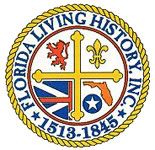 Florida Living History, Inc. periodically updates Historic City News readers by submitting items from their historic research.
Florida Living History, Inc. periodically updates Historic City News readers by submitting items from their historic research.
In March of 1565, Admiral Don Pedro Menéndez de Avilés y Alonso de la Campa, Comendador of the Holy Cross of Zarza of the Knights of Santiago, Captain-General of the Indies Fleet, Governor of Cuba, is awarded a contract by Felipe II of Spain, appointing him adelantado (frontier governor) of Florida.
At that time, Spanish Florida consisted of all of North America from the Keys north to Newfoundland and west to New Spain (today’s Mexico). Menéndez’ contract charges him, within three years and without cost to the Crown, to explore, conquer, and colonize the land and begin its conversion to the Holy Faith.
When, 10 days after the contract is signed, Felipe II learns of an “illegal” settlement of French Huguenots on today’s St. Johns River – Fort Caroline, under René de Laudonnière – he adds 300 royal soldiers and 15,000 ducats, making the Enterprise of Florida a joint venture.
When spies report that Admiral Jean Ribault of France is on his way to reinforce the fort, Menéndez sails for Puerto Rico, then, with a force of more than 1,000, up the Gulf Stream to the mouth of the St. Johns.
Ribault, however, has won the race for Florida; his ships, too large to cross the bar of the St. Johns, lay at anchor outside the channel. Menéndez encounters the French ships and forces them to flee.
He falls back to the nearest harbor to off-load supplies from his flagship, the great galleas San Pelayo, and has his men fortify the bay-side native Timucuan village of Seloy.
There, on September 8, 1565, to the sound of drums, trumpets, and artillery, witnessed by cheering soldados and colonists, as well as mystified natives, Menéndez lands and officially takes possession of Florida in the name of His Most Catholic Majesty, formally establishing the municipality of San Agustín (present-day St. Augustine) as part of the Spanish Empire.
The settlement that Pedro Menéndez de Avilés founded has survived for 445 years upon its original site.
Soliìs de Meraìs, Gonzalo; ed. and trans. by Jeannette Thurber Connor; Pedro Meneìndez de Avileìs: Adelantado, Governor and Captain-general of Florida: A Memorial; Florida State Historical Society, Deland, FL; 1923.
Barrientos, Bartolome; trans. by Anthony Kerrigan; Pedro Meneìndez de Avileìs, Founder of Florida; University of Florida Press, Gainesville, FL; 1965.
Hoffman, Paul E.; A New Andalucia and a Way to the Orient: The American Southeast during the Sixteenth Century; Louisiana State University Press, Baton Rouge, LA; ISBN: 0807115525; 1990.
Hoffman, Paul E.; The Spanish Crown and the Defense of the Caribbean, 1535-1585: Precedent, Patrimonialism, and Royal Parsimony; Louisiana State University Press, Baton Rouge, LA; ISBN: 0807124273; 1980.
Lyon, Eugene: The Enterprise of Florida: Pedro Menéndez de Avilés and the Spanish Conquest of 1565-1568; University Presses of Florida, Gainesville, FL; ISBN: 0813005337; 1976.
Manucy, Albert C.; Meneìndez: Pedro Meneìndez de Avileìs, Captain General of the Ocean Sea; Pineapple Press, Sarasota, FL; ISBN: 1561640158; 1992.
Waterbury, Jean Parker; The Oldest City: St. Augustine Saga of Survival; St. Augustine Historical Society, St. Augustine, FL; ISBN: 0961274409; 1983.
Weber, David J.; The Spanish Frontier in North America; Yale University Press, New Haven, CT; ISBN: 0300051980; 1992.
Written by Davis Walker and posted courtesy of Florida Living History, Inc.
Florida Living History, Inc. is a non-profit 501(c)(3) organization dedicated to educating the public about Florida’s colonial and territorial history. The organization strives for high standards in historical interpretation and supports educational initiatives that promote a greater understanding and appreciation of Florida’s rich and diverse heritage.
Discover more from HISTORIC CITY NEWS
Subscribe to get the latest posts sent to your email.
